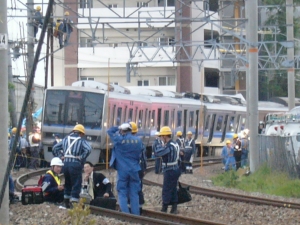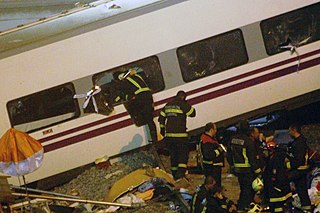
The Hatfield rail crash was a railway accident on 17 October 2000, at Hatfield, Hertfordshire. It was caused by a metal fatigue-induced derailment, killing four people and injuring more than 70.

The 2005 JR Amagasaki derailment occurred in Amagasaki, Hyōgo Prefecture, Japan, on 25 April 2005 at 09:19 local time, just after the local rush hour. It occurred when a seven-car commuter train came off the tracks on West Japan Railway Company's Fukuchiyama Line in just before Amagasaki on its way for Dōshisha-mae via the JR Tōzai Line and the Gakkentoshi Line, and the front two cars rammed into an apartment building. The first car slid into the first-floor parking garage and as a result took days to remove, while the second slammed into the corner of the building, being crushed into an L-shaped against it by the weight of the remaining cars. Of the roughly 700 passengers on board at the time of the crash, 106 passengers, in addition to the driver, were killed and 562 others injured. Most survivors and witnesses claimed that the train appeared to have been travelling too fast. The incident was Japan's most serious since the 1963 Tsurumi rail accident.
The railways of New South Wales, Australia have had many incidents and accidents since their formation in 1831. There are close to 1000 names associated with rail-related deaths in NSW on the walls of the Australian Railway Monument in Werris Creek. Those killed were all employees of various NSW railways. The details below include deaths of employees and the general public.
A runaway train is a type of railroad incident in which unattended rolling stock is accidentally allowed to roll onto the main line, a moving train loses enough braking power to be unable to stop in safety, or a train operates at unsafe speeds due to loss of operator control. If the uncontrolled rolling stock derails or hits another train, it will result in a train wreck.

Yilan is a railway station of Yilan line of the Taiwan Railways Administration located at Yilan City, Yilan County, Taiwan.

The Taroko Express is an express train service of the Taiwan Railways Administration, and is part of Tze-Chiang Limited Express. The name of the service comes from the 19-kilometre (12-mile) long Taroko Gorge, which is one of Taiwan's most popular tourist spots, and the Truku people. It began commercial operations on 16 February 2007.

The Puyuma Express is a type of railway service on Taiwan Railways (TRA) notable for using tilting trains. It began commercial service on 6 February 2013 during the Spring Festival.

The Santiago de Compostela derailment occurred on 24 July 2013, when an Alvia high-speed train traveling from Madrid to Ferrol, in the north-west of Spain, derailed at high speed on a bend about 4 kilometres (2.5 mi) outside of the railway station at Santiago de Compostela. Out of 222 people on board, 143 were injured and 79 died.

On 9 November 2016, a tram operated by Tramlink derailed and overturned on a sharp bend approaching a junction. Of a total 69 passengers, there were seven fatalities and 62 injured, 19 of whom sustained serious injuries. This was the first tram incident in the United Kingdom in which passengers died since 1959.

On 15 November 1991, two passenger trains collided in Miaoli County, Taiwan, killing 30 people and injuring 112. It was the deadliest train accident in Taiwan since 1948 until April 2021 when 49 passengers were killed after a train derailed in Hualien.

The Stonehaven derailment was a fatal railway accident that occurred at 09:38 BST on 12 August 2020, when a passenger train returning to Aberdeen hit a landslip, near Carmont, west of Stonehaven in Aberdeenshire, Scotland, following severe rain. Of the nine people aboard, three were killed, and six were injured.

On 2 April 2021, at 09:28 NST (01:28 UTC), a Taroko Express train operated by the Taiwan Railways Administration (TRA) derailed at the north entrance of Qingshui Tunnel in Heren Section, Xiulin Township, Hualien County, Taiwan, killing 49 people and injuring at least 200 others. At the time of the accident, the train was carrying 494 passengers. The eight-carriage train derailed after colliding with a construction truck that had fallen down a slope onto the tracks north of Hualien City; the train came to rest in the tunnel, with severe damage and many casualties.













